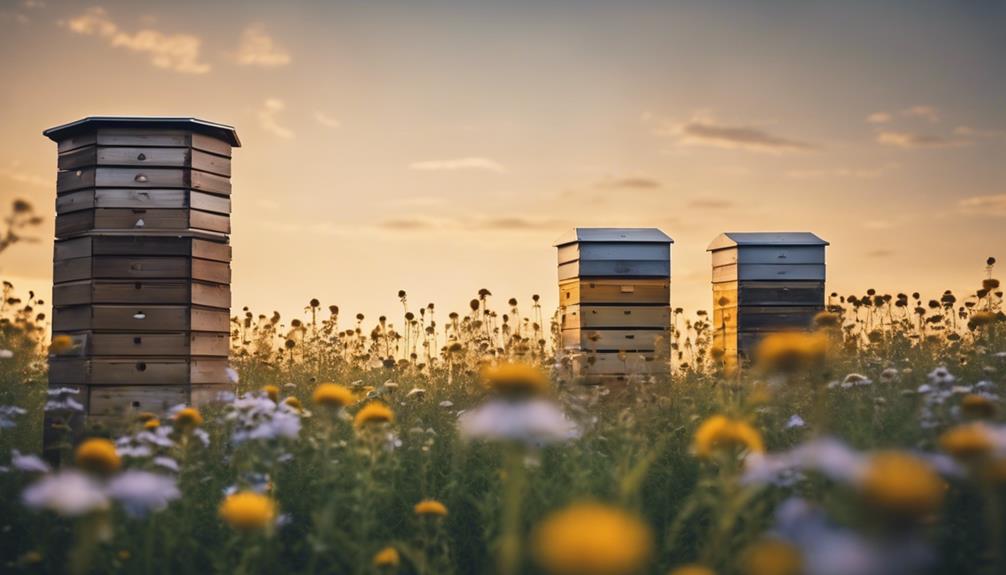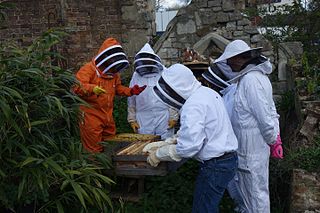
In modern beekeeping, the shift from traditional methods is clear. Sophisticated hive designs, innovative tools, and organic hive management techniques are now key. This change prioritizes bee and environmental well-being. In the past, ancient beekeepers stuck to simple hives made from natural materials. They cherished a raw connection to bees with little technology. Nowadays, beekeepers focus on efficiency and sustainability. By adopting these modern practices, they can better support bee health and ecosystem balance. Want to discover more about how these shifts have shaped the beekeeping world?
Historical Background of Beekeeping Methods
In ancient times, beekeepers explored simple hives made from natural materials to house bees for honey production. Imagine the freedom of those beekeepers, crafting homes for their buzzing friends using only what nature provided.
These traditional methods were all about simplicity and working in harmony with the environment. No fancy gadgets or complicated setups – just pure, raw connection with the bees and their sweet honey. Back then, beekeeping was a true labor of love, a dance between humans and nature that yielded golden rewards.
It's fascinating to think about how far we've come from those humble beginnings. As you investigate the historical background of beekeeping methods, remember the roots of this ancient practice and the freedom it represents.

Tools and Equipment Comparison
Comparing the tools and equipment used in traditional and modern beekeeping methods reveals significant advancements in efficiency and productivity. When you look at the tools of the trade, you'll notice that modern beekeepers have adopted innovations that make their work easier and more streamlined. Here are some key differences to ponder:
- Traditional Beekeeping: Smoke was generated by burning materials like leaves and straw. Hives were made from natural materials like straw and clay. Honey extraction involved crushing combs by hand. Protective gear was limited to simple veils and gloves. Monitoring hive health relied heavily on visual inspections.
Adopting modern tools and equipment has transformed beekeeping practices, making the process more efficient and less labor-intensive.
Approach to Bee Health Management
When considering the management of bee health, a proactive approach is essential for guaranteeing the well-being of Urban beekeeping your bee colonies. Regular inspections of your hives can help you catch any signs of disease or pests early on.
Making sure your bees have access to a variety of flowers for nectar and pollen is vital for their nutrition and overall health. Additionally, implementing integrated pest management techniques can help control pests without harming your bees.
It's important to stay informed about the latest research and best practices advanced beekeeping books in bee health management to provide the best care for your colonies. By staying proactive and attentive to the needs of your bees, you can help them thrive and guarantee a successful beekeeping operation.
Honey Production Techniques
To maximize honey production in your beekeeping operation, optimizing hive placement and maintaining a consistent supply of blooming flowers are key factors to take into account. Here are some tips to help you improve your honey production techniques:
- Strategic Hive Placement: Position hives in areas with ample sunlight and protection from harsh winds. Diverse Floral Sources: Guarantee a variety of blooming plants are available near the hives for bees to collect nectar from. Regular Hive Inspections: Check on your hives frequently to monitor honey production and address any issues promptly. Harvesting Timing: Time your honey harvesting to coincide with peak production periods for maximum yield. Proper Extraction Methods: Use efficient and bee-friendly methods to extract honey while maintaining hive health.
Evolution of Beekeeping Practices
As beekeeping has advanced over time, beekeepers have continually adjusted their practices to improve efficiency and sustainability in managing bee colonies. Traditional beekeeping methods, rooted in age-old techniques, have evolved into modern practices that prioritize the well-being of the bees and the environment.
Beekeepers now use sophisticated hive designs, innovative tools, and scientific knowledge to boost colony health and honey production. Techniques such as integrated pest management and organic hive management have become more prevalent, reducing the reliance on chemical treatments and promoting natural beekeeping practices.
Frequently Asked Questions
Can Beekeeping Practices Impact Local Ecosystems?
Beekeeping practices can significantly impact local ecosystems. Your decisions on hive placement, pesticide use, and forage sources can affect not just your bees but also nearby plants, animals, and water sources. Be mindful.
How Do Beekeepers Address Bee Swarming Behavior?
When bees swarm, beekeepers act swiftly to prevent chaos. Think of it like a skilled conductor guiding a harmonious orchestra. You'll learn to anticipate swarming cues and use techniques to maintain hive health.
What Role Do Pesticides Play in Modern Beekeeping?
In modern beekeeping, pesticides are used to control pests and diseases, but they can harm bees if not managed carefully. You must be mindful of using pesticides that are bee-friendly to protect your bees' health.
Are There Differences in Bee Species Preferred for Beekeeping?
When keeping bees, you can select from different Beekeeping books species like Italian, Carniolan, or Buckfast bees. Each type has distinct characteristics that may fit your beekeeping style and environment better. Discover and find your match!
How Do Weather Patterns Affect Beekeeping Operations?
In beekeeping, weather patterns play a vital role. You must adapt to changing conditions to guarantee hive health and productivity. Monitor temperature, rainfall, and wind to make informed decisions that support your bees.